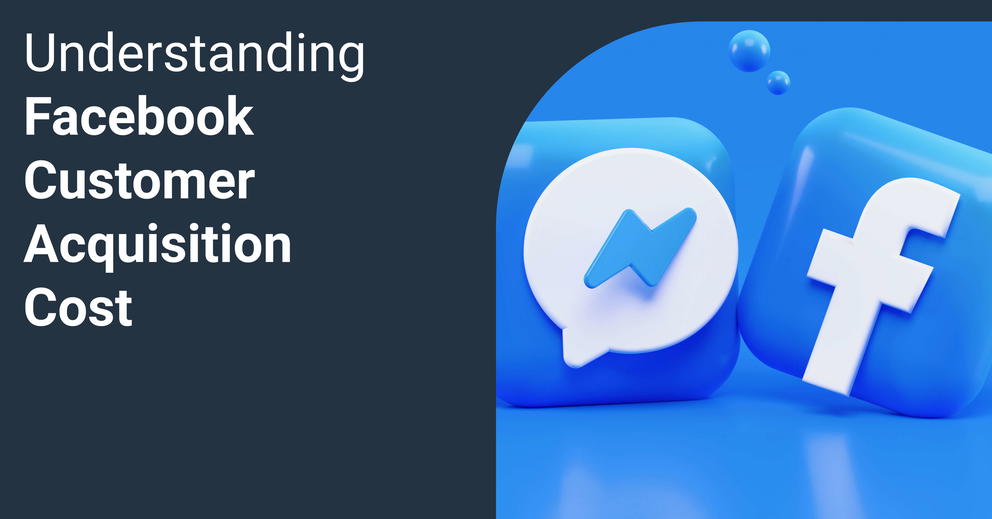Facebook CAC: Analyzing, Reducing & Improving It
For successful business growth, you need to expand your customer base. In most cases, consumers won’t find your brand unless the paid marketing is implemented. Marketers will have to spend time, money and other resources to acquire buyers. And sometimes, Facebook CAC (customer acquisition cost) can put up an expensive price tag.

Jul 20 2021●7 min read

Although Facebook Ads are used by 93% of digital marketers and advertising spend reached over $31.43 billion in 2020, some advertisers still face difficulties while trying to scale their business through Facebook. It’s like a thin line marketer is walking between profitability and excessive spending.
It’s important to understand the basics of Facebook CAC (customer acquisition cost), how to analyze it, reduce the cost and improve the overall customer lifetime value.
What is Facebook CAC and how to calculate it?
CAC is the cost of convincing a potential customer to buy a brand’s product or service. For years in the companies, the term has been circling, focused on scaling their businesses through digital marketing efforts. Once Facebook has introduced advertising opportunities on their platform, marketers have started to rely heavily on it, as the platform gathers 1.88 billion active users daily.
To calculate CAC, the marketer will need to divide all the costs spent acquiring customers against the number of new customers picked up. For example, if a marketer spends $500 on Facebook Ads yearly and receives 200 new customers, the CAC is $2.5.
Advertisers using Facebook Ads can save tons of time and import their campaign data into the reporting tool. Using Whatagraph’s Smart Builder, marketers can effortlessly build easy-to-digest visual reports with the most important campaign metrics, such as customer acquisition costs, customer lifetime value and more. With all of the performance data in one place, advertisers will be able to make insights-driven decisions on what engages with the customers the best, what could be improved and most importantly - how to reduce CAC.
Is Facebook any good for new customer acquisition?
With such a big audience in hand, Facebook is a great tool to acquire new customers. Facebook Ads also provides advanced targeting options, which helps marketers focus ad spend on the people who are most likely to make a purchase. Creative ad options allow displaying ads that are unique, eye-catching and interactive.
However, if the ad campaign is not standing out in the advertiser-crowded platform or the audience targeting is wrong, CAC might be higher than the ROI (return on investment) itself.
Most marketers were worried that CAC would rocket up with the release of Apple’s iOS14 update, which allows users to opt out of tracking through the apps without their consent. However, marketer Mickael Assaf monitored over a hundred advertisers’ results on Facebook Ads before the new Apple’s privacy policy and after the update. Both the CAC and CR (conversion rate) did not change dramatically. For some advertisers, metrics even improved.
The average customer acquisition cost
The average CAC is different for every industry. Databox polled various advertisers, including ad agencies specializing in Facebook and shared some interesting insights.
Roughly half of the respondents have CAC below $10: 28% of respondents report a customer acquisition cost of less than $5, another 28% have their CAC between $6-10. 7% of respondents said their customer acquisition rates are higher than $100.
The lowest customer acquisition cost is being held by primarily fast-moving consumer goods companies, offering discounts, sales, and exclusive deals, highly engaging with the users.
The CAC higher than $100 is mainly acquired by B2B and high-end tech businesses. As Facebook is not a popular choice for the B2B industry or high-end technology fans, the acquisition cost is skyrocketing.
How to reduce Facebook CAC
There are many reasons why customer acquisition costs can increase. The marketer’s goal should be a steady decline in CAC because it leads to a significant increase in revenue and has almost endless potential for scaling. If you are having a high CAC while running Facebook Ads, here are some tips on how you can reduce it:
- Redefining the brand’s target audience. Broader is not always better. The world is constantly changing, and so does the consumer’s behavior. Taking a step back and evaluating the brand’s core customer is always important. Redefining the demographics and understanding what the new customer might be is essential. While running a new campaign, marketers can target “new” as the users who have never purchased before, never visited a website or didn’t buy anything from the website for a month. Taking a glimpse at the business target audience and spotting the changes will drastically reduce customer acquisition costs.
- Choosing the right campaign. Running A/B tests with lookalike audiences or different campaign visuals will allow the advertiser to test various marketing efforts and see what brings the best results. Eliminating the ineffective and scaling the ads performing well will help optimize the budget and get customers at the best advertising price possible.
- Focus on content more. As the marketer is practically running an ad to cold audiences, they need to present the content that would spark an interest in the user. Marketers have limited time to impress the potential customer, and animated videos can do a lot to draw attention to the ad and increase engagement. Videos don’t have to be heavily produced — even slideshows or animated gifs can help the ad stand out against the static ads. Presenting the users with the ad they want to engage in is a straightforward ticket to generating the most conversions with the smallest customer acquisition cost. Content marketing can help you to get your message to the right audience and drastically reduce CAC.
Most importantly - analyze your marketing efforts. The biggest help a marketer can get - reporting tools like Whatagraph. It gathers all of the marketing efforts data and presents it in a visual report. Analyzing the campaign data will allow marketers to compare the performance of different ads, see what marketing efforts get the best results and help reduce the CAC.
Customer lifetime value
Customer acquisition cost is important. However, it’s also vital to make the customer stay with your brand for the long run. The CAC and CLV (customer lifetime value) are going hand in hand.
While customer acquisition cost resembles the value it takes to acquire a customer, customer lifetime value is the other half of the equation - what happens once the business has the customer and what the customer is bringing to the company. Ultimately, the less it costs to acquire new customers and the more overall value each customer brings, the more profit business is going to make.
To increase customer lifetime value, transforming one-time buyers into repeat and loyal customers is crucial. Here are a few tips on how to make customers stay:
- Make sure you go for the quality. Nobody likes to get bad quality products or services and if the customer is not satisfied with the quality your business provided the first time, he won’t likely come back. Focusing on quality will eliminate all of the customer’s thoughts to look at your competitors.
- Promote loyalty. Creating a loyalty program for customers to collect points and exchange them for the extra discount or bonus items will drastically increase CLV. A survey conducted by Motista shows that brands offering a connection such as rewards programs have 306% higher customer lifetime value than those who do not provide one.
- Buying in bulk or getting a subscription. Upselling or offering customers a subscription for your products or services will raise the CLV. Directly showcasing potential customers the value they are getting when staying with the brand for the long run will convert one-time buyers into brand ambassadors.
Bottom line
While at the early stages of the business, the relatively high CAC is normal to take place in a market, the company’s further growth is based on the decreasing customer acquisition cost and high customer lifetime value. CAC allows marketers to understand how much it costs to acquire a new customer and CLV is showcasing how much the business is making from the new customer.
It’s important to analyze the Facebook Ads campaigns constantly. The insights made from the collected metrics showcase the ineffective marketing efforts, allow marketers to improve the running campaigns and bring the high customer lifetime value at the lowest customer acquisition costs possible.

WRITTEN BY
Benediktas KazlauskasBenediktas is a detail-oriented writer with a passion for marketing and technology. Using his vast experience in Business Management and Sales, he approaches every blog with the same idea: How to make readers come back for more?


